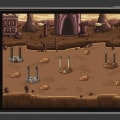In the world of user interface design, there are many essential elements that work together to create a visually appealing and functional layout. One of these crucial elements is the use of whitespace and visual hierarchy. These two concepts may seem simple, but when used correctly, they can greatly enhance the overall design and user experience of a website or application. In this article, we will delve into the importance of whitespace and visual hierarchy in UI design, and how they can be effectively utilized to create a seamless and engaging interface.
Whether you are a beginner or an experienced designer, understanding these concepts is vital for creating successful and user-friendly designs. So let's dive in and explore the world of whitespace and visual hierarchy in UI design. Whitespace refers to the empty space between design elements on a page or screen. It may seem counterintuitive, but whitespace is just as important as the elements themselves. It helps to create balance, organize content, and guide the user's eye to important information. Visual hierarchy, on the other hand, is the deliberate arrangement of design elements in a way that directs the user's attention and creates a sense of order.
This is achieved through the use of size, color, contrast, and spacing. For example, larger text or images will naturally draw more attention than smaller ones. Similarly, contrasting colors can create visual interest and guide the user's eye to specific areas of the design. By utilizing whitespace and visual hierarchy effectively, you can greatly improve the usability and visual appeal of your website or mobile app. These two elements work together to enhance the user experience by making it easier for users to navigate and understand the content on your platform. When it comes to UI design best practices, whitespace and visual hierarchy are essential components that should not be overlooked.
They play a crucial role in creating a visually appealing and functional interface that engages users and keeps them coming back. To make the most out of whitespace, keep in mind that less is often more. Too much whitespace can make a design feel empty and lacking in substance. On the other hand, not enough whitespace can make a design feel cluttered and overwhelming. The key is finding the right balance that creates a harmonious and visually pleasing layout. In terms of visual hierarchy, it is important to establish a clear hierarchy of information on your website or app.
This means that the most important elements should stand out and be easily noticeable, while less important elements should be placed in the background. This can be achieved through the use of size, color, contrast, and spacing, as mentioned earlier. Another important aspect of visual hierarchy is consistency. Maintaining consistency in design elements such as font styles, colors, and spacing helps to establish a sense of order and cohesion throughout the interface. This makes it easier for users to understand and navigate your platform. In conclusion, whitespace and visual hierarchy are two essential elements for creating an effective and visually appealing user interface design.
They work together to create balance, guide the user's eye, and organize content in a way that enhances the overall user experience. By utilizing these elements effectively, you can greatly improve the usability and visual appeal of your website or mobile app.
Utilizing Visual Hierarchy
When it comes to creating an effective user interface, visual hierarchy is a crucial element to consider. It refers to the arrangement of elements on a page in a way that guides the user's attention and creates a sense of order. In other words, it helps users understand what is most important and where to focus their attention. Utilizing visual hierarchy in UI design is essential because it helps users navigate through a website or app more easily.Without a clear visual hierarchy, users may feel overwhelmed and struggle to find what they are looking for, leading to a negative user experience. To create an effective visual hierarchy, designers use various techniques such as size, color, contrast, and spacing. By using these elements strategically, designers can guide the user's eye towards the most important elements and create a flow that makes sense.
Understanding Whitespace
To create a successful design, it's important to understand the role that whitespace plays. Whitespace, also known as negative space, is the empty area between elements in a design. It may seem like a simple concept, but it has a significant impact on how a user interacts with and perceives a design. One of the main functions of whitespace is to create visual balance and organization.By strategically using whitespace, designers can guide the user's eye to important elements and create a sense of hierarchy. This helps users navigate the design more easily and find the information they are looking for. Whitespace also allows for a cleaner and more minimalist design. It gives elements room to breathe and prevents the design from feeling cluttered or overwhelming. This can lead to a more pleasant user experience and make the design feel more refined and professional. Additionally, whitespace can also improve readability and legibility.
By creating enough space between lines of text and around paragraphs, designers can make the content easier to read and digest. This is especially important for websites and mobile apps, where users are often scanning for information rather than reading every word. When it comes to using whitespace in UI design, less is often more. It's important not to overuse or underuse whitespace, as both can have negative effects on the overall design. Finding the right balance is key to creating an effective and visually appealing design. In conclusion, understanding the role of whitespace in design is crucial for creating successful UI designs.
By utilizing whitespace effectively, designers can improve visual hierarchy, balance, organization, readability, and overall user experience. Experimenting with different amounts of whitespace and its placement can help designers find the perfect balance for their specific design projects.
Resources for UI Design
use HTML structure with UI design and visual hierarchy only for main keywords and Whitespace and visual hierarchy are essential elements in creating an effective and visually appealing user interface design. But how can you make sure you're utilizing these elements to their full potential? Luckily, there are many helpful resources and tools available to enhance your UI design projects. Here are a few that we recommend: 1.Canva: This online design platform offers a wide range of templates, graphics, and tools to help you create stunning designs with ease.You can use Canva to experiment with different layouts and compositions, as well as incorporate whitespace and visual hierarchy into your designs.
2.Adobe Color:
Choosing the right color scheme is crucial in creating a visually appealing design. With Adobe Color, you can explore different color combinations and create custom palettes to use in your UI design projects.3.Google Fonts:
Typography plays a significant role in visual hierarchy, and Google Fonts offers a vast library of free fonts to choose from. You can search for fonts by style, popularity, or language, making it easier to find the perfect typeface for your design.4.Whimsical:
This collaborative wireframing and prototyping tool allows you to create interactive mockups of your UI designs. You can use it to test out different layouts and compositions and see how whitespace and visual hierarchy affect the overall user experience. These are just a few examples of the many resources available for UI design.By utilizing these tools and incorporating whitespace and visual hierarchy into your designs, you can create a more effective and visually appealing user interface that will elevate your overall design projects.
Tips and Techniques for UI Design
Use HTML structure with whitespace and visual hierarchy to create a clean and organized layout. Incorporate ample whitespace around important elements such as buttons, text, and images to give them breathing room and make them stand out. This not only improves the overall aesthetic of the design but also helps with visual hierarchy by drawing the user's attention to key elements.Additionally, use a consistent color scheme and font hierarchy to establish a clear visual hierarchy. This means using different font sizes, weights, and colors to differentiate between headings, subheadings, body text, and other elements. Another helpful technique is to use grids in your design to create a sense of order and balance. This will help guide the user's eye and make it easier for them to navigate through your interface.
Lastly, don't be afraid to experiment with different layouts and designs to find what works best for your specific project. Remember, whitespace and visual hierarchy are not just design trends, but essential elements for creating a user-friendly and visually appealing interface. Whitespace and visual hierarchy are essential elements for creating a user-centered design that is both visually appealing and easy to use. By understanding how these elements work together and utilizing them effectively, you can greatly improve the usability and success of your website or mobile app.


